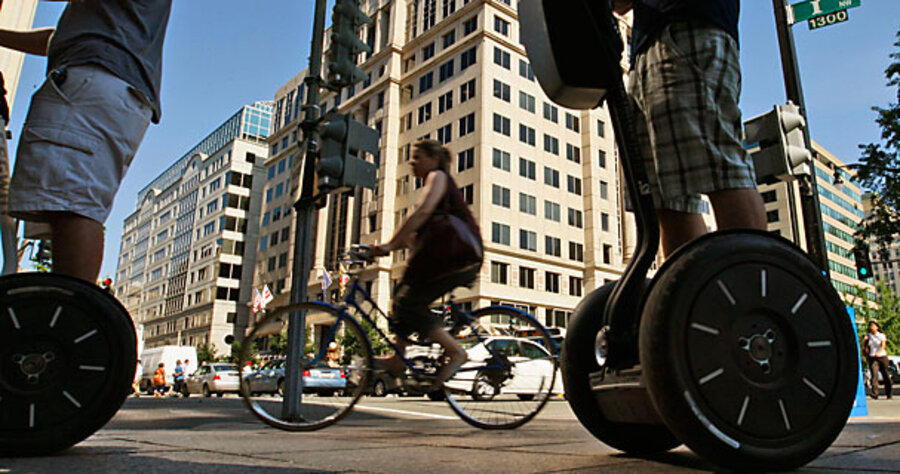Segway sales up
Loading...
I have to admit this one surprised me. Over the past month or so, I've written about how Americans, in response to record gas prices, are now driving less, buying scooters, working four-day weeks, eschewing gas-guzzlers, driving slower, snapping up hybrids, and taking the train more.
But Segways?
Sure enough, the Associated Press is reporting that the electric two-wheeled self-balancing personal transporters are flying off the shelves, or whatever they put them on, in record numbers.
While Segway Inc. declines to release its sales figures, the AP quotes two dealers who have seen banner months for the Segway, which retails for around $5,000. A spokeswoman for the company told the AP that dealers have seen an increase of 30 to 40 percent in "walk-in traffic," and the CEO predicts a sales growth rate of 40 to 50 percent for this year.
Who's buying them? A story in The Wall Street Journal points to university campus police, parking-enforcement officers, and pizza deliverymen.
But both stories also quote commuters who are ditching their cars so that they can Segway to work. The AP spoke with Columbus, Ohio's Paul Feeney, who Segways 1.4 miles to his job, and John O'Connor, who Segways 4 miles. In California, the Wall Street Journal quoted Yorba Linda's Scott Hervey, a custodian who commutes about 12 miles on his Segway to his job at Disneyland. "I like passing gas stations," he told the Journal.
Unless he charges his Segway at work, Mr. Hervey probably can't run too many errands on the way home; the thing has a maximum range of 25 miles.
And the speed tops out at 12.5 miles per hour. Given these limitations, it's hard to see the Segway as a viable replacement for the automobile. It looks more like a replacement for cycling and walking.
But right now, the Segway is probably not yet having a major impact either way. Victor Godinez, a blogger for The Dallas Morning News, estimates that about 40,000 Segways have been sold since it was first released in 2001. He compares that with the 18.2 million bicycles sold since 2000.
Looking at these comparatively low figures, Andrew Smith, another blogger for the Morning News, offers up an incisive and dyspeptic rant against the Journal for what he sees as a bogus trend piece.
It's hard to disagree with him. With it's $5,000 price tag – $11,000 if you want a red one with a Ferrari logo – the Segway is little more than a toy for the rich.
Even for our Disneyland custodian who maxes out the range every day, the economics benefit isn't huge. Let's say that you live in California and commute 25 miles per day in your car, which for simplicity's sake we will say gets 25 miles per gallon. That means you're probably spending around $4.70 a day on gas for your commute. Now lets suppose that you stop driving your car and buy a $5,000 Segway. Even if you get free electricity, it will still take you almost three years for your Segway to pay for itself.
But who knows. Maybe gas prices will continue to rise, and maybe the Segway's price will fall, making it the transport of choice for the masses.
To the extent that it cuts fossil fuel consumption, I suppose that would be a good thing, as long as they keep the sidewalks are clear for those of us who prefer to walk.
[via Grist]





